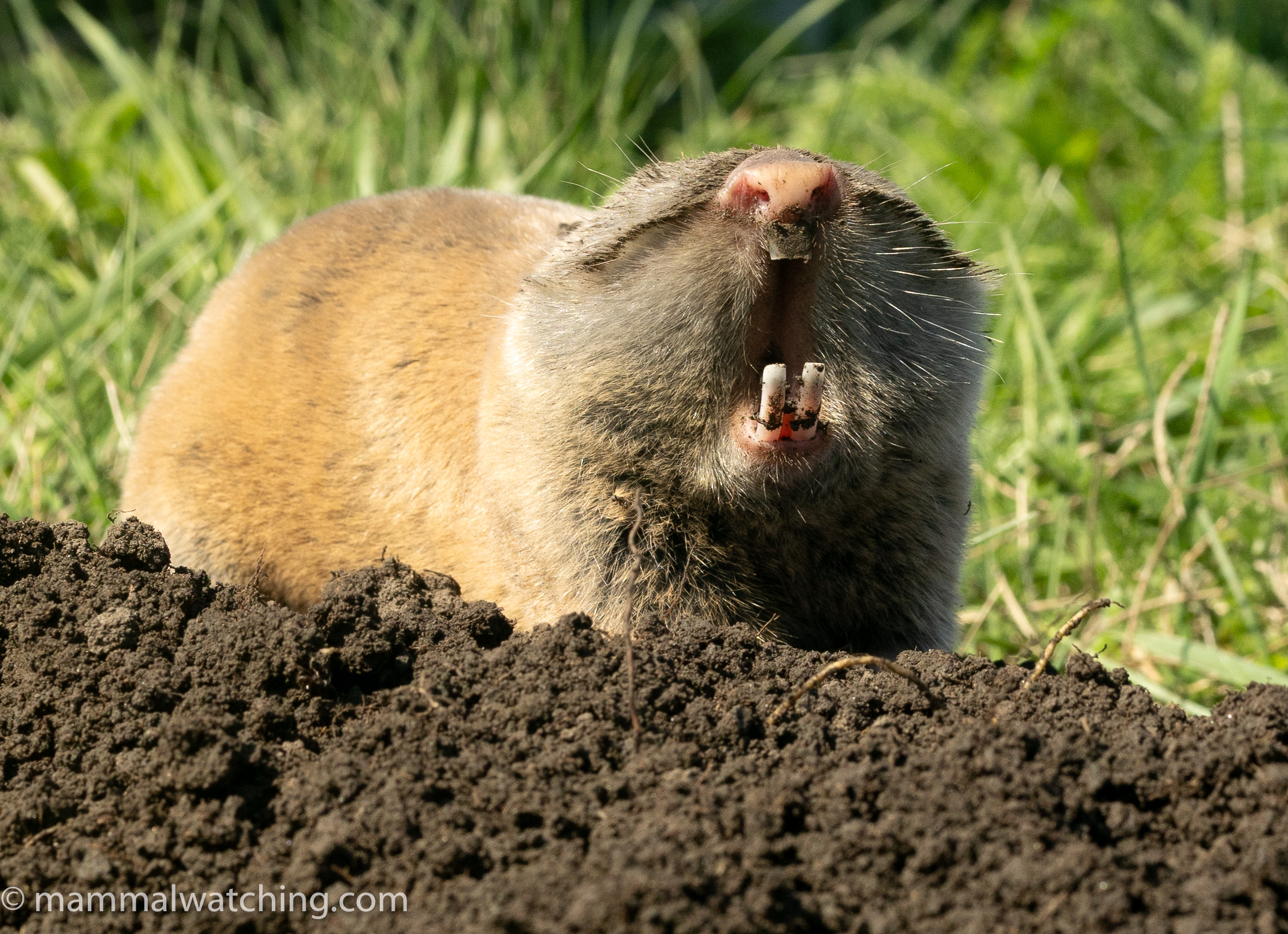
Zen and the Art of Mole-rats: Romania, April 2025
The Japanese have some wonderful words, including one that describes ‘buying a book and leaving it unread’ and another ‘death from overworking’. I can identify with the former. With the latter not so much.
As you might imagine from the land of Haiku they have poetic vocabulary around nature. For instance, ‘木漏れ日’ (komorebi) is ‘sunlight filtering through the trees’. So I am convinced that if mole-rats lived in Japan, and mole-rat watching was a Japanese thing , the language would have one word to describe the ‘existential nothingness that overtakes a person who has spent several hours staring, motionless, into a mole-rat tunnel and seen nothing but soil and the occasional beetle’.
Californians pays thousands of dollars to attend Buddhist retreats which cannot come close to the transcendental oneness with everything that a mole-rat safari produces. There is surely a market for gopher meditation near silicon valley. (Venture capitalists please contact me at the usual address).
That said, no amount of Zen training can compensate for the moment the hole you have been staring at for three hours is slowly filled with soil from below by an animal that doesn’t even offer a glimpse of itself. Even the best Buddhist would be contemplating a stick of dynamite or a ferret at this point.
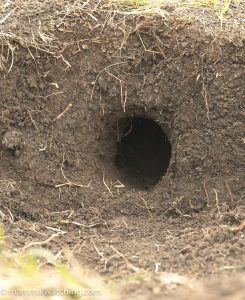
Before
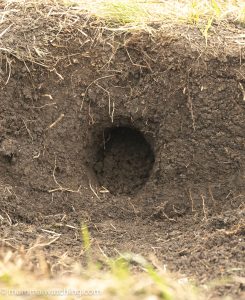
After
The Tour
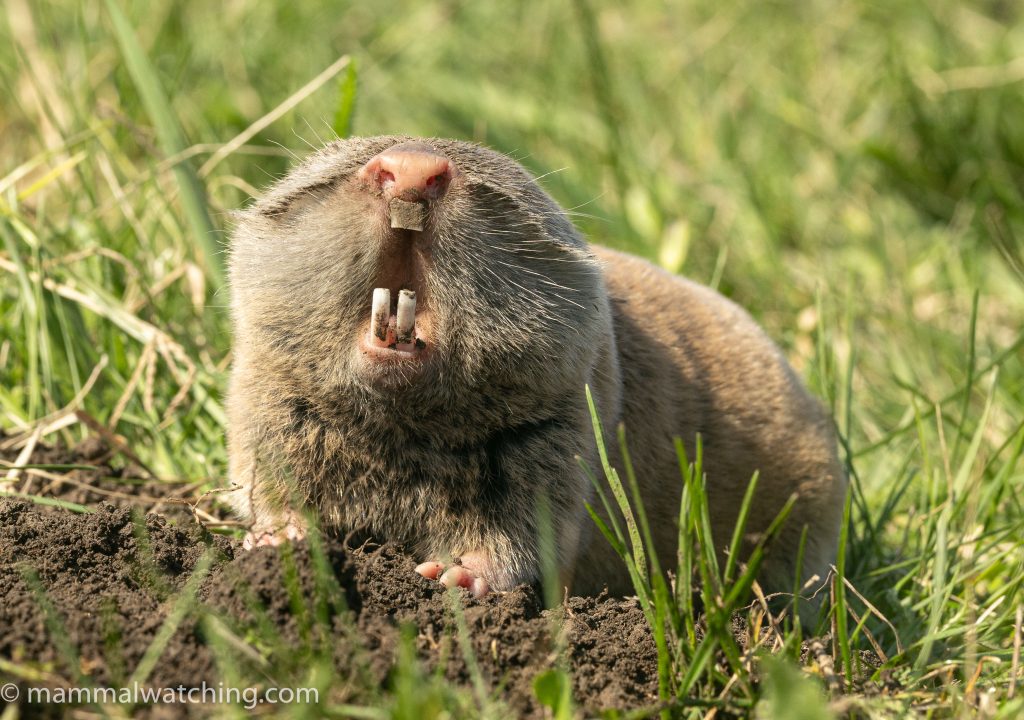
Bukovina Blind Mole-rat (Spalax graecus)
Sakertours’s first – but not last – mole-rat safari is about as niche as mammalwatching has ever been. Indeed I cannot imagine it getting any more niche. So it was an honor when János Oláh, the head of Sakertours, invited me to Romania in search of four species of mole-rats in April 2025.
We stayed in cosy, comfortable accommodation and ate far too much excellent food including huge portions of papanasi which roughly translates as ‘donut of infinite calories’. And I fell in love with Romania. Not just for the papanasi … the abundance of wildlife, the friendliness of the people and the feeling of space also played a part.
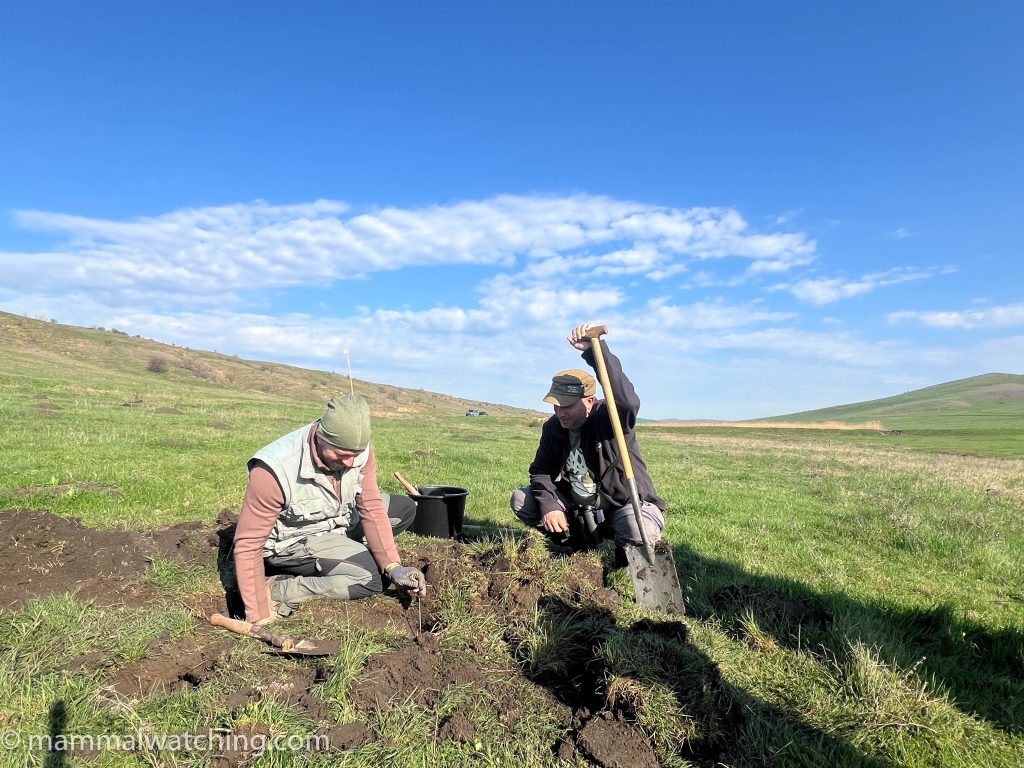
János & Zsolt on the job
I have been championing the cause of fossorial rodent watching for a decade or more. It really is – and please try to believe me if you haven’t tried it yet – a thrill to watch a gopher, zokor or mole-rat briefly stick its nose out of the hole you are sitting beside. This video from Mark Hows, of a Mehely’s Mole-rat, tries to capture that excitement. Now imagine this after you have been staring into that hole for six hours. In the rain. And freezing wind. When you didn’t bring the right clothes. Elation and relief in equal measure make for a powerful high.
Thrilling as the prospect of a week’s rodent watching was, I was as excited about time in the company of János and Carlos Bocos, two of my favourite mammalwatchers. We also had the famous Zsolt Hegyeli with us, mole-rat expert and all round good guy, plus another four participants who were great company. Now we just needed some shovels and a bit of luck.
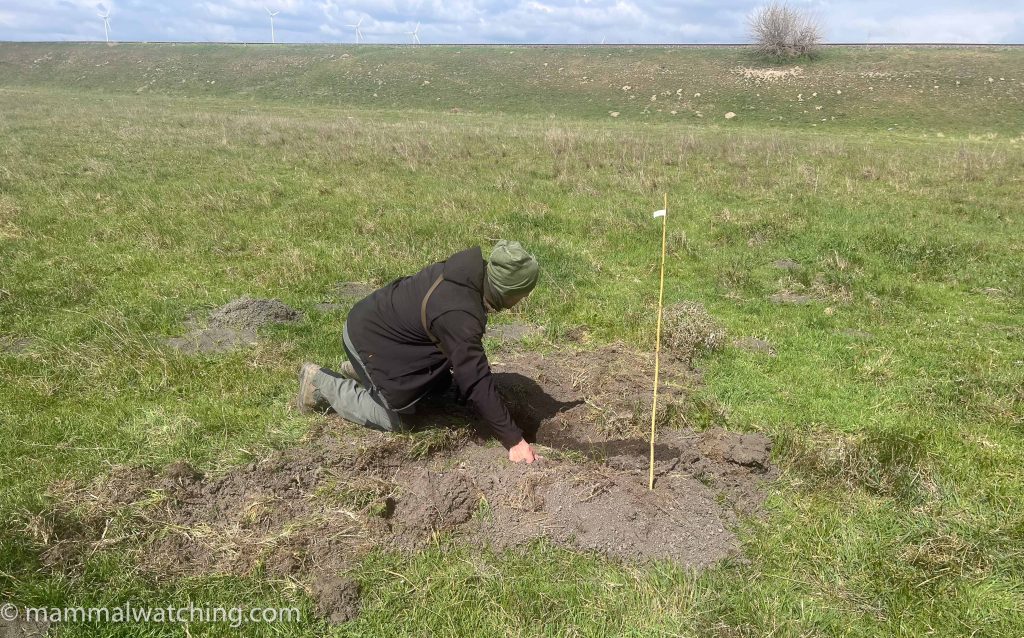
The trip was meticulously planned and organised by Sakertours and we circumnavigated Romania to visit three locations for our four target mole-rats. Sakertours’s itinerary is here. I was reminded at how well birding companies like Sakertours run mammal trips. They leave very little to luck and if they list a species, there is every likelihood you will see it.
Even if you love looking for mole-rats as much as I do, I am not sure a detailed trip report is going to be of much interest to anyone. There is only so much I can say about spending every day looking for fresh mounds and sitting in front of them waiting for action. We saw our first two target species quickly, each within a matter of hours. The warm weather helped our energy levels and we suspect played a part in encouraging the animals to cooperate.
But then a cold weather system was parked over Central Europe for five days. Temperatures dropped by 10C, the wind got strong and it seemed always to be raining or about to start.
Looking for mole-rats was no longer as enjoyable as it had been. And the two species we were still chasing became a lot harder to see.
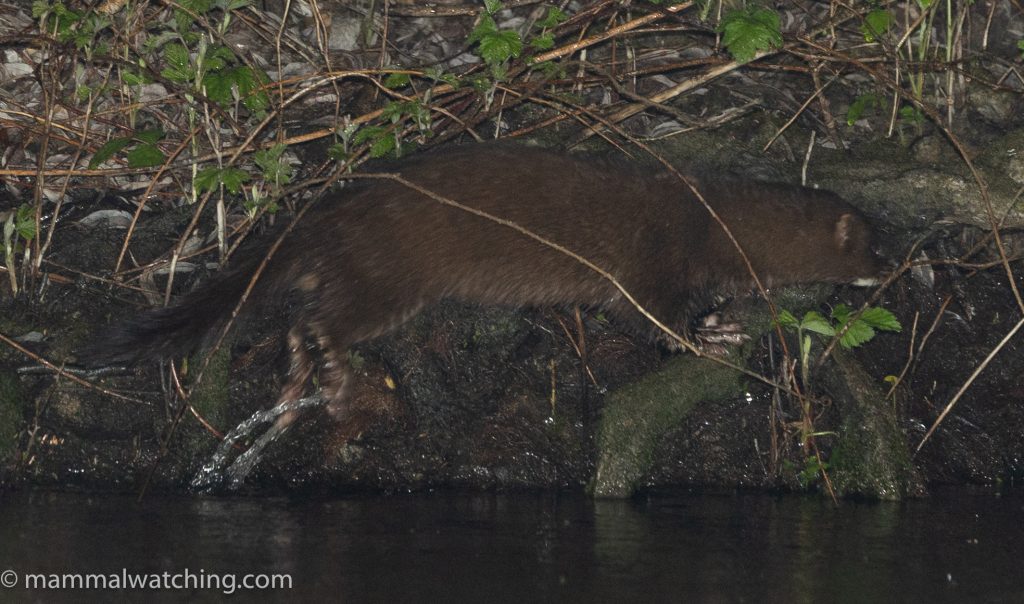
European Mink (Mustela lutreola)
So rather than a trip report I will pitch the mole-rat movie: a movie that needs to be made!
There was, of course, a supporting cast of other mammals along the way, including a fabulous cameo appearance by a European Mink.
Act 1. Lesser Blind Mole-rat
Setting: Constanta, Southeast Romania
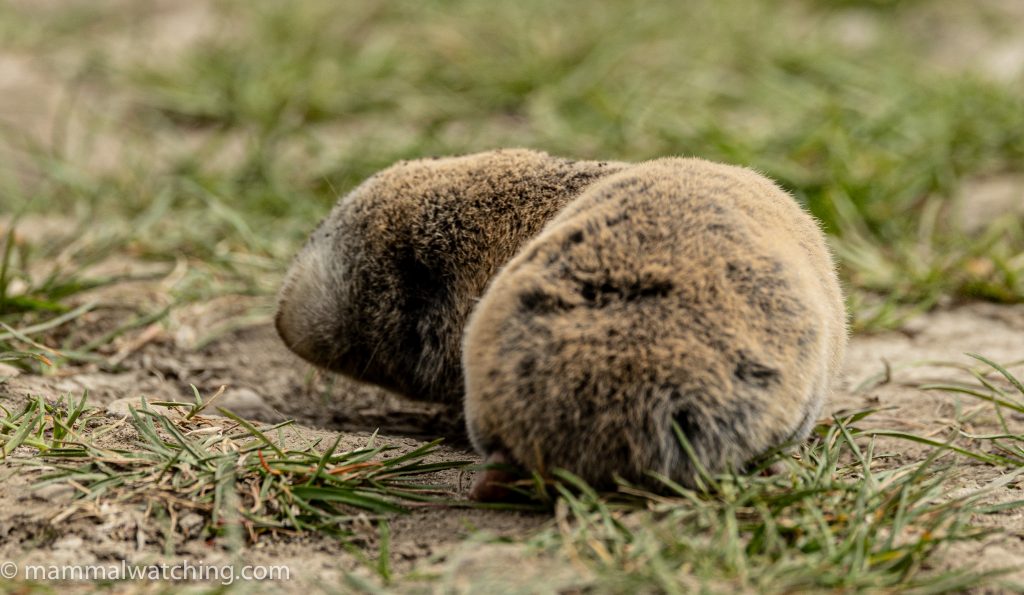
Lesser Blind Mole-rat (Nannospalax leucodon)
Our story starts at breakneck speed. We spy our first target in an hour.
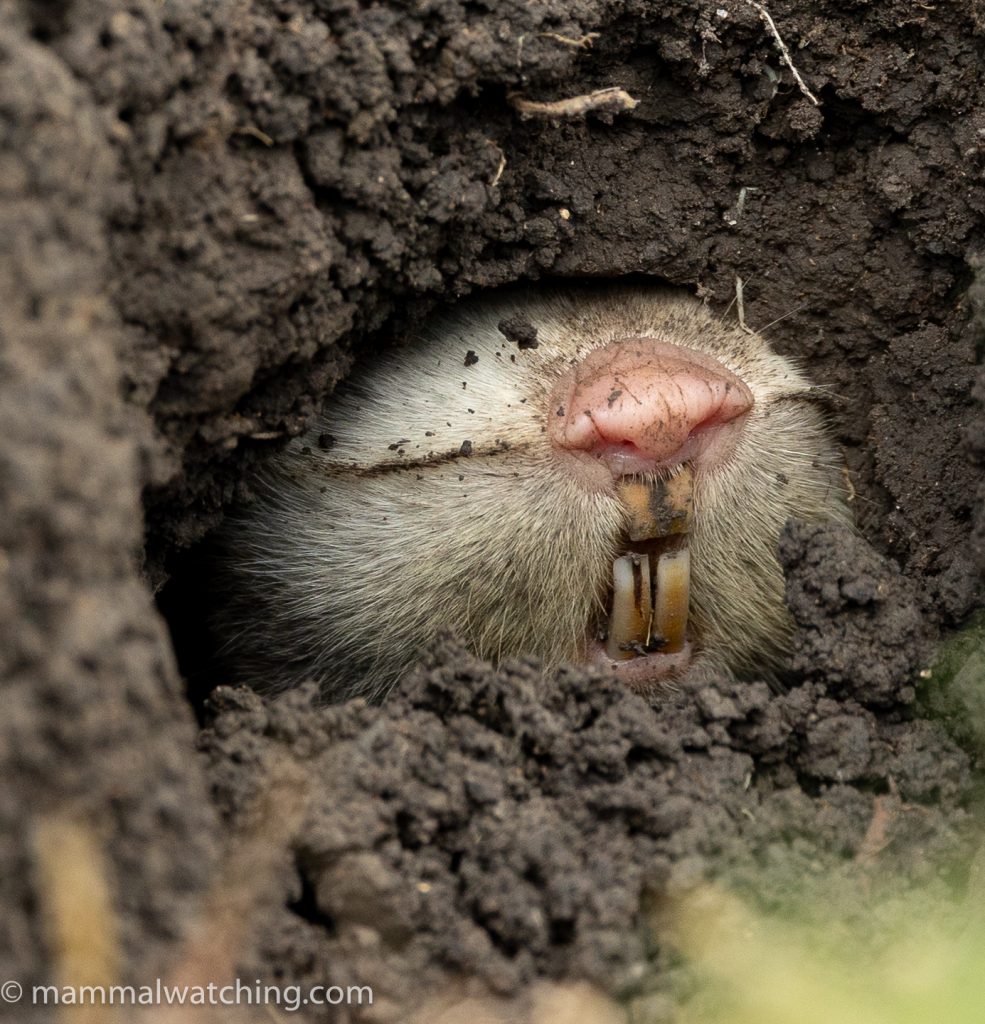
Lesser Blind Mole-rat (Nannospalax leucodon)
With adrenalin coursing through our veins we celebrate over coffee in a gas station. The drama rises to fever pitch when we get the call that an animal is waiting for us back at the study site.
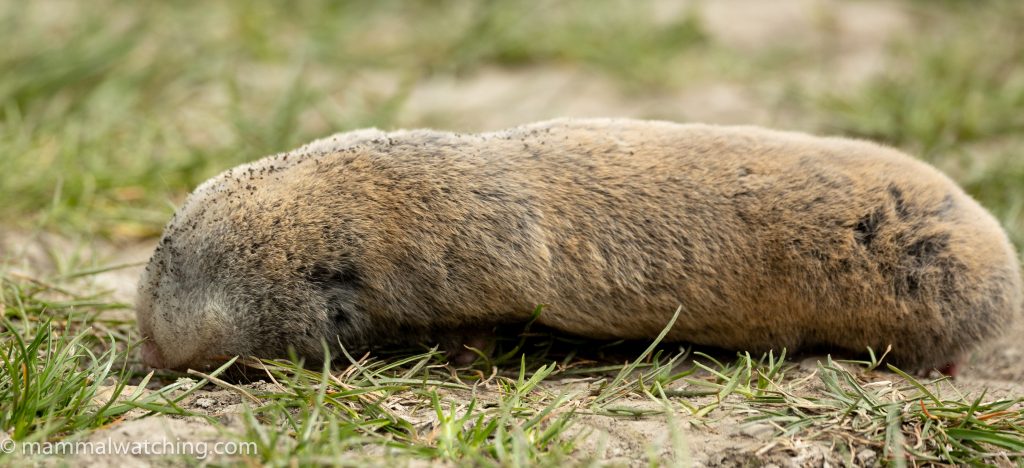
Lesser Blind Mole-rat (Nannospalax leucodon)
What a start! The audience is left wondering whether the team can maintain this strong opening.
Act 2: Bukovina Blind Mole-rat
Setting: Iasi, Northeast Romania
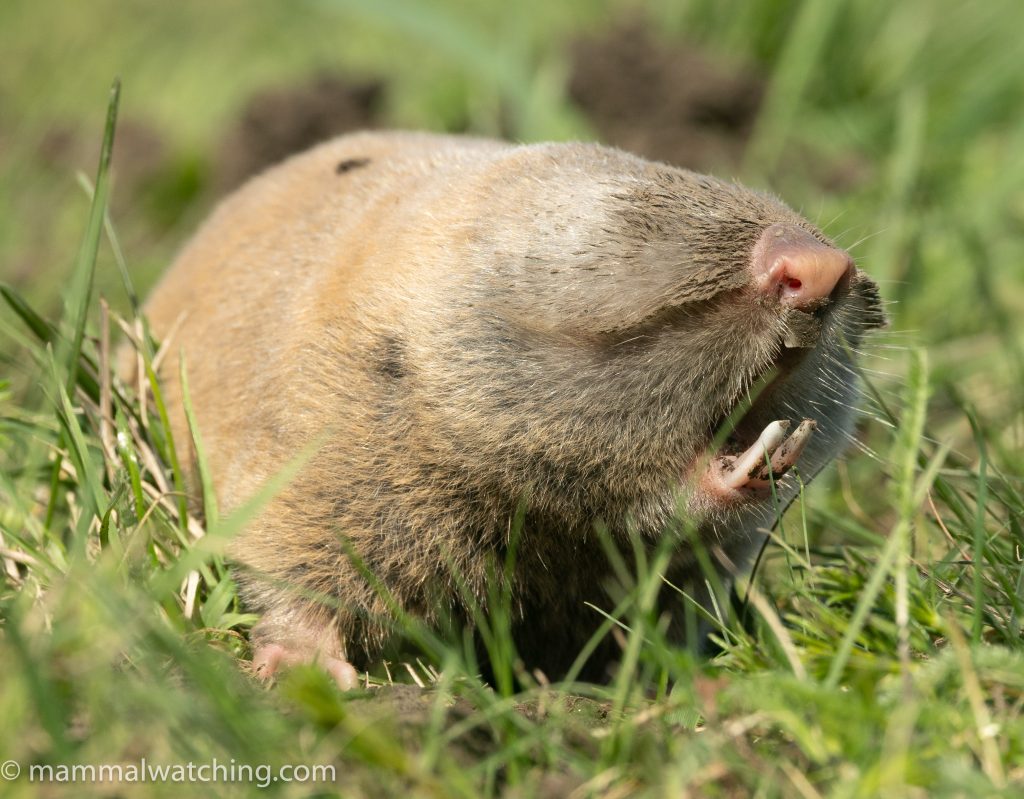
Bukovina Blind Mole-rat (Spalax graecus)
Flushed with success the group moves north to search for their second target, the larger Bukovina Blind Mole-rat, from the Spalax not Nannospalax genus. Once again Zsolt delivers the goods in under an hour and we have a thrilling encounter with a fearsome animal.
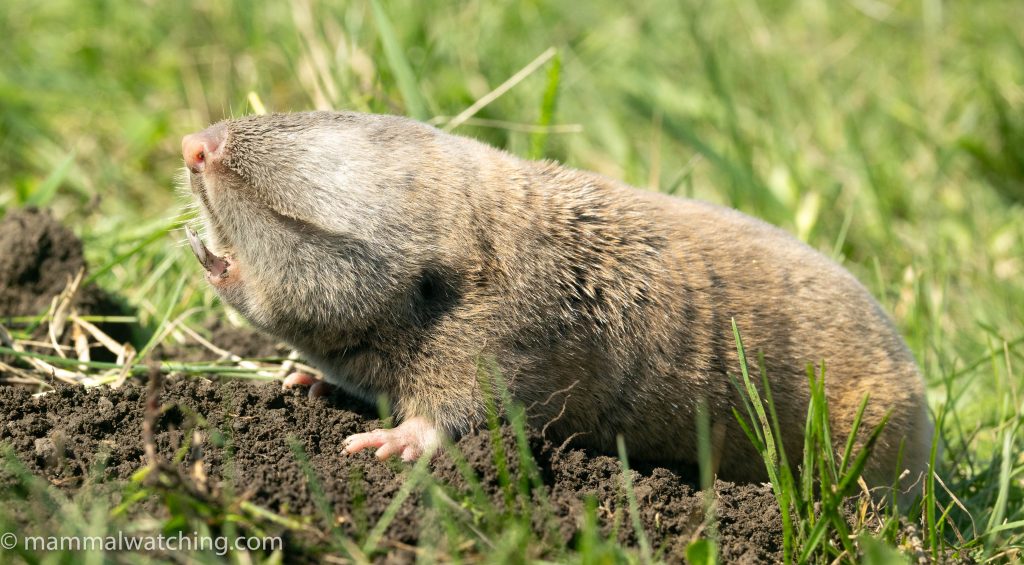
Bukovina Blind Mole-rat (Spalax graecus)
Easy peasy lemon squeezy. We are ahead of schedule and leave for our next destination a day early.
Act 3: Mehely’s Blind Mole-rat
Setting: The Bihar Mountains, Central Transylvania
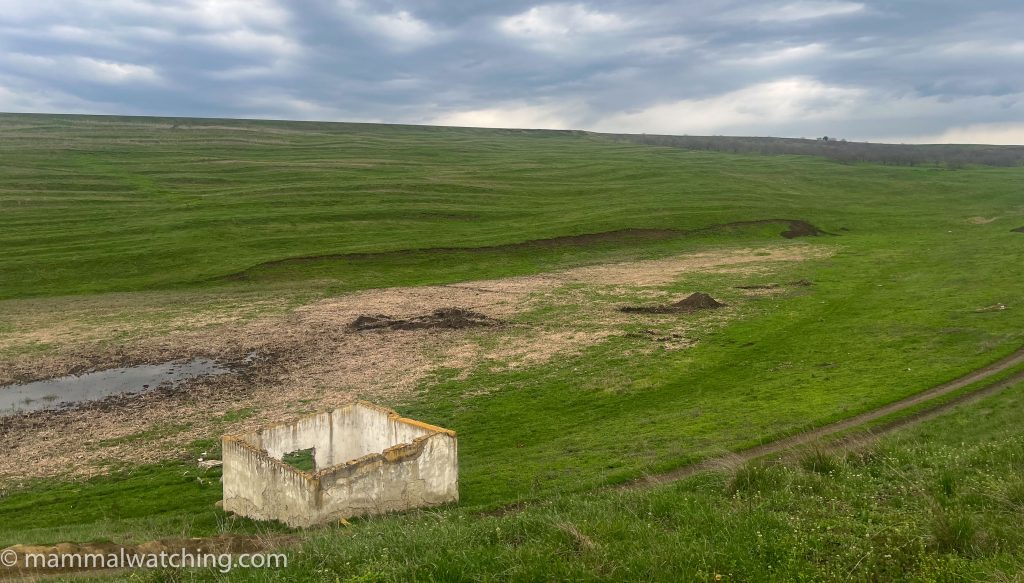
Bukovina Mole-rat Habitat. Also a good site for a Romanian gulag.
The camera pans out across a windswept ridge line. The mole-rat watchers huddle together as freezing rain gusts into their faces. They have been here three days. Only a very few of the group have had a glimpse of the third species. Tensions mount. Tempers are about to fray. Emotions are pushed to the very brink of a breakdown. Will the group self-destruct in a fit of rage?
In fact it took five days for me to finally see Mehely’s Blind Mole-rat. And then all I saw was a face as it hovered for a second or two below its entrance hole before retreating for cover. A tickable face however.
Was it worth it? Definitely? Do I need clinical help? Definitely.
(In the end all but two of us saw one or more Mehely’s Mole-rat, Romania’s only endemic mammal. Perhaps it was the change in the weather or perhaps the species is generally more skittish than its cousins, but they seemed reluctant to show themselves when people were close. János had the most luck, surprising several animals during his routine inspections of potentially active burrows. But on several occasions an animal appeared at the hole next door to – or once on the different side of – the hole I was sitting next too. Character building stuff).
Act 4: Hungarian Blind Mole-rat,
Setting: The Bihar Mountains, Central Transylvania
I had seen this species before, in Hungary, so stayed behind on the Nannspalax hungaricus day to catch up on work.
The others eventually caught a glimpse of an animal at the end of a long, wet and very cold day.
Closing Credits
Setting: Hargita Bear Lodge, Transylvania
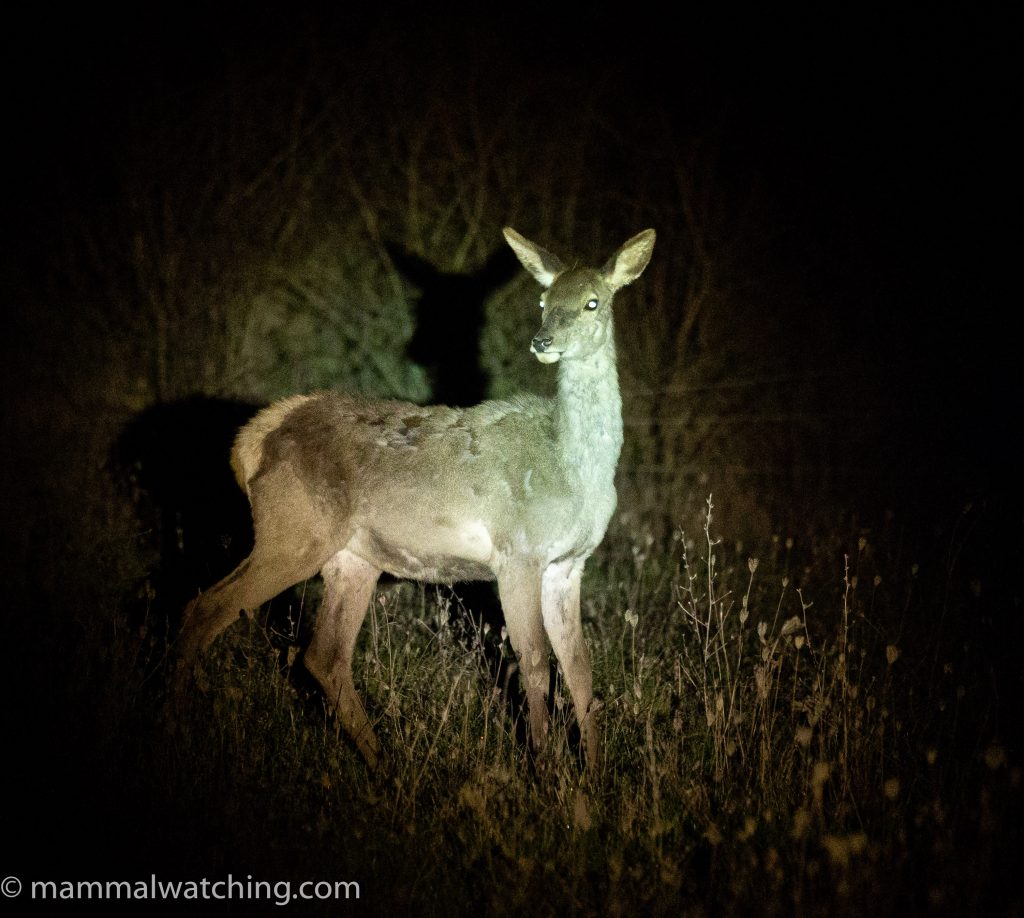
Red Deer (Cervus elaphus)
The sun sets over the comfortable Hargita Bear Lodge. Our protagonists relax over brandy, beer and a bear or two.
The End.
János had planned for us to spend the final day looking at bears from the hide near the Hargita Bear Lodge. We gave up on the plan in order to give the now infamous Mehely’s Blind Mole-rat one more try. So we spent just our final night at the lodge and took a brief – but productive – night drive which featured a couple of bears.
Finding Mole-rats
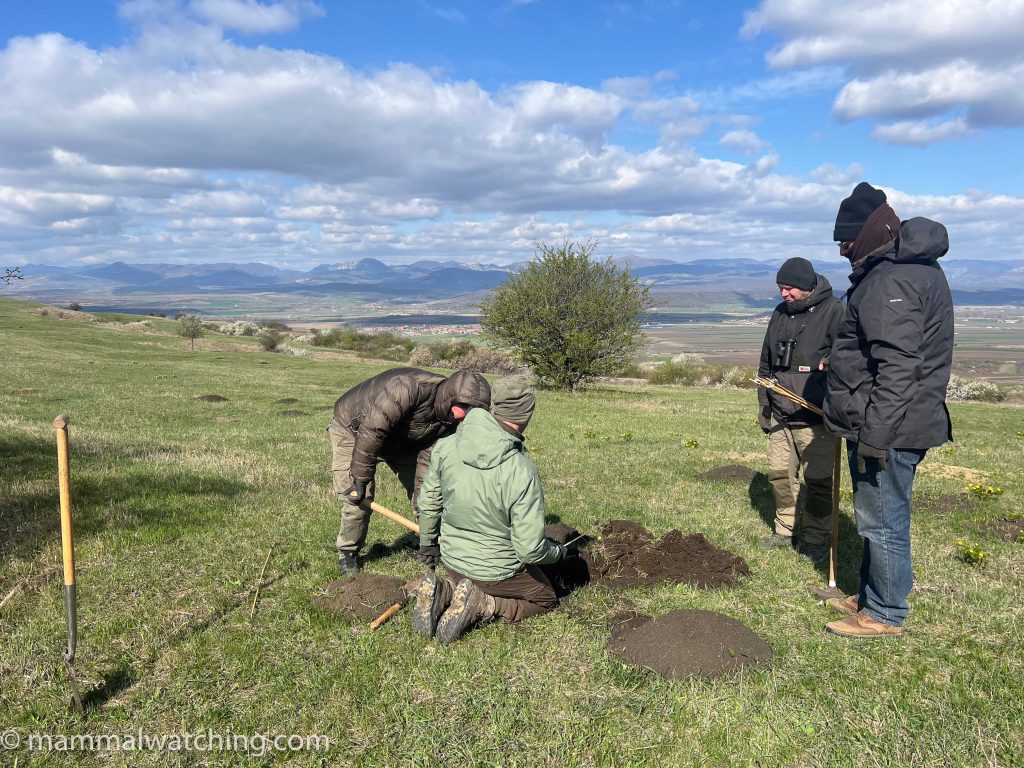
The best technique for seeing a mole-rat, without specialised help, appears to be the same method you might use for a pocket gopher, a tuco-tuco or a zokor. Find some fresh mounds and carefully remove the soil to expose the tunnel system to the air. Mole-rats seems quite fastidious about resealing their burrows and so if an animal is close by it will often fill the hole with fresh earth in an hour or two.
My signature recipe runs like this.
- find some fresh diggings and open up at least five or six mounds that are well spaced apart so you have a better chance of targetting different animals (one animal might have made several fresh mounds across its complex tunnel system).
- Go for lunch and eat papanasi.
- Return to see which holes have been re-sealed, as this means an animal is active in the burrow.
- Gently re-open one and take position. The animal will often reappear within 15 minutes
There does seem to be a rhythm to mole-rat behaviour and in my limited experience the pattern is similar among different fossorial rodents, though wariness levels may differ.
I have seen a zokor return to the entrance hole five times I removed the soil plug. But mole-rats may be more suspicious. With this method it feels like you may have only one shot to spot a mole-rat. We found that once an animal had resealed its hole a second time it did not show itself, either not returning or resealing the tunnel a metre or more before the entrance and well out of view. Of course don’t read much into this as it is based on a very small set of observations in the springtime. But I saw another mole-rat species in Bulgaria the following week (report coming soon) and it was a similar story.
In some countries this sort of activity might attract the attention of the locals. Not in Romania. Apart from being politely questioned by a deputy mayor on our first day (he was concerned we were trying to drill for water …😂😂) we were left alone. No one stopped to ask why eight people were sitting in the cold in folding chairs in a field, surrounded by camera gear and staring at the ground.
Catching the animals is a different story. Researchers use different methods and for mole-rats Zsolt’s technique could well become a new martial art competition in the Olympics. The sort of live gopher traps I have used in the USA are apparently not all that effective with mole-rats.
All The Mammals
European Hare (Lepus europaeus)
Seen most days.
European Ground Squirrel (Spermophilus citellus)

European Ground Squirrel (Spermophilus citellus)
We saw several colonies around Constanta. Animals had recently remerged from hibernation.
Common Muskrat (Ondatra zibethicus) – introduced
We saw a couple during our Danube Delta night cruise out of Mila 23.
Mound-building Mouse (Mus spicilegus) (probable)
We saw several mice – mainly in thermal scopes -at night in bushes along the road side near Constanta. I think they were very likely this species as the behaviour and habitat was very like where I’d seen Mound-building mice before in Hungary.
Brown Rat (Rattus norvegicus) – introduced
Abundant in the Danube Delta after dark.
Hungarian Blind Mole-rat (Nannospalax hungaricus)
I missed the Hungarian Mole-rat day. The weather was terrible but the group finally saw an animal briefly at the very end of the day.
Lesser Blind Mole-rat (Nannospalax leucodon) – lifer
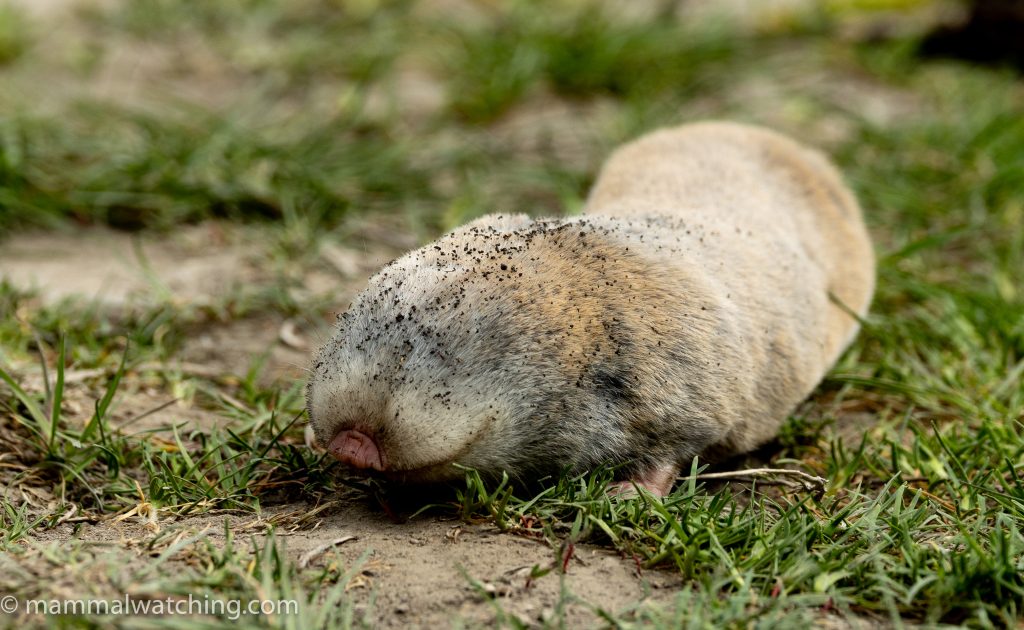
Lesser Blind Mole-rat (Nannospalax leucodon)
One animal seen near Constanta.
Mehely’s Blind Mole-rat (Spalax antiquus) – endemic – lifer
I finally got a glimpse after five days. I don’t think I have every committed so much time to see a single species. Snow Leopard, Giant Panda and Giant Pangolin were all easier.
Bukovina Blind Mole-rat (Spalax graecus) – lifer
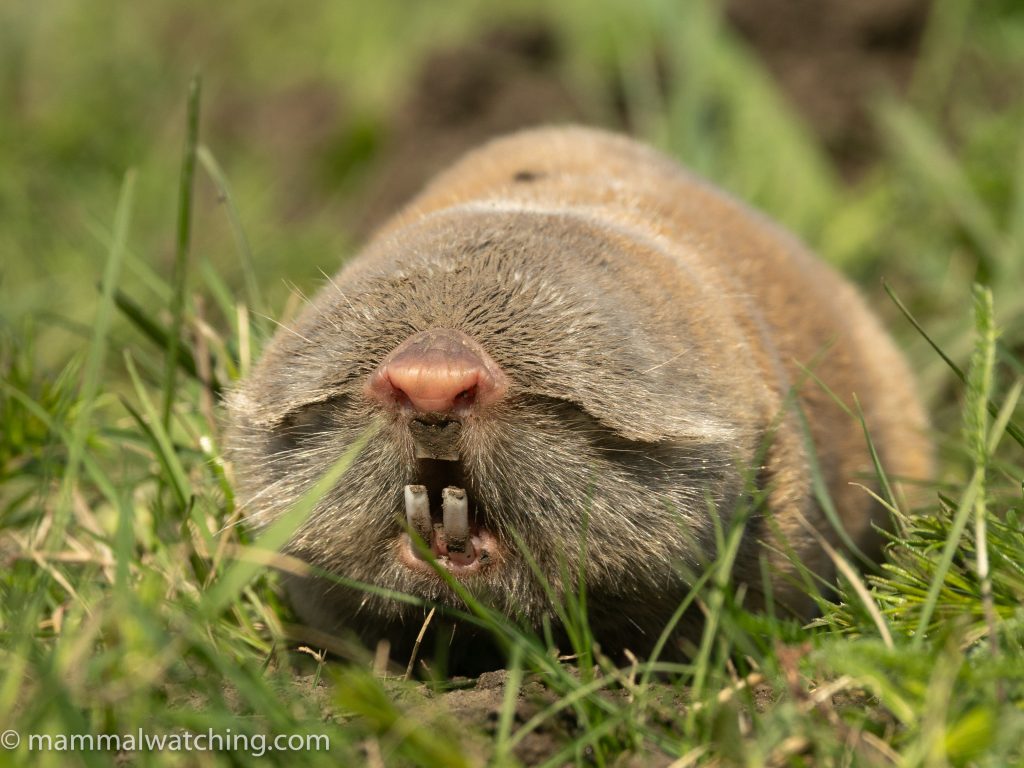
Bukovina Blind Mole-rat (Spalax graecus)
A great species that – thanks to Zsolt’s expertise – we got up close and personal with for an hour near Iasi.
Northern White-breasted Hedgehog (Erinaceus roumanicus)
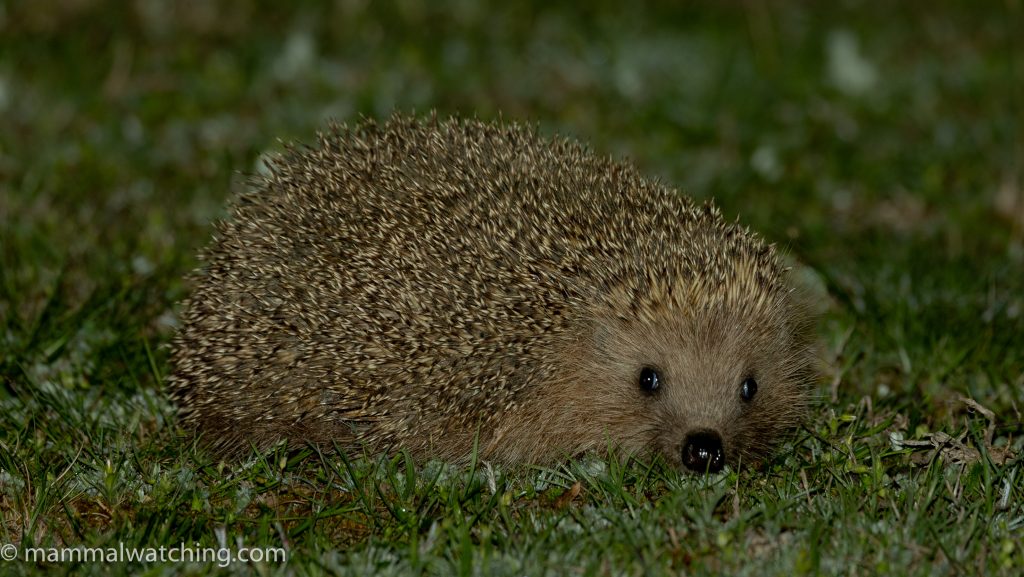
Northern White-breasted Hedgehog (Erinaceus roumanicus)
We didn’t spend much time looking for mammals after dark but hedgehogs were common when we did. We saw them around Constanta, Rimetea and Hargita.
Bicolored White-toothed Shrew (Crocidura leucodon): lifer
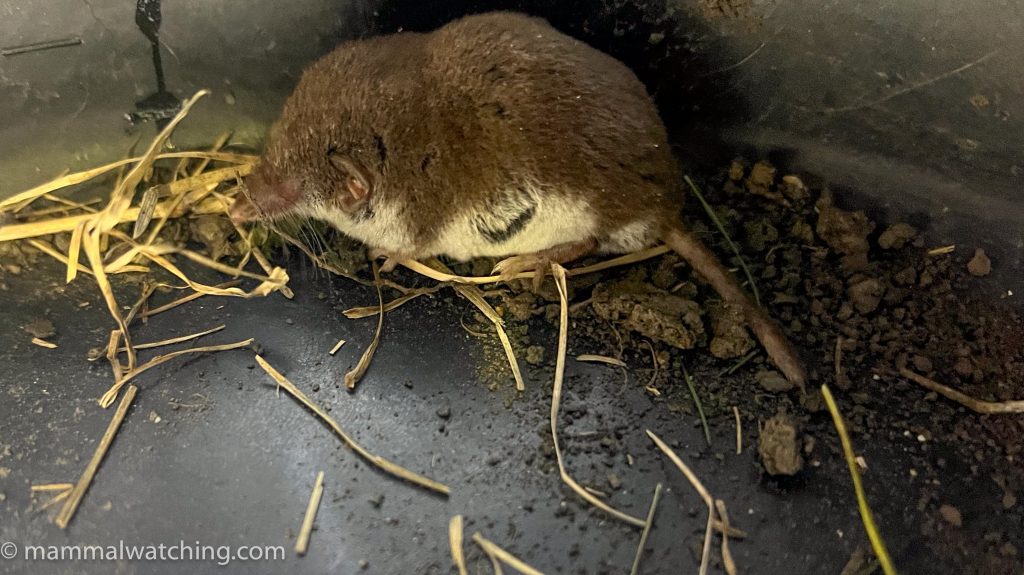
Bicolored White-toothed Shrew (Crocidura leucodon)
We set 30 small mammal traps in grassland near Iasi for just a few hours. The weather was awful so we collected them at 11pm and had only one capture: my lifer Bi-colored White-toothed Shrew. They are apparently common in the area.
Stone Marten (Martes foina)
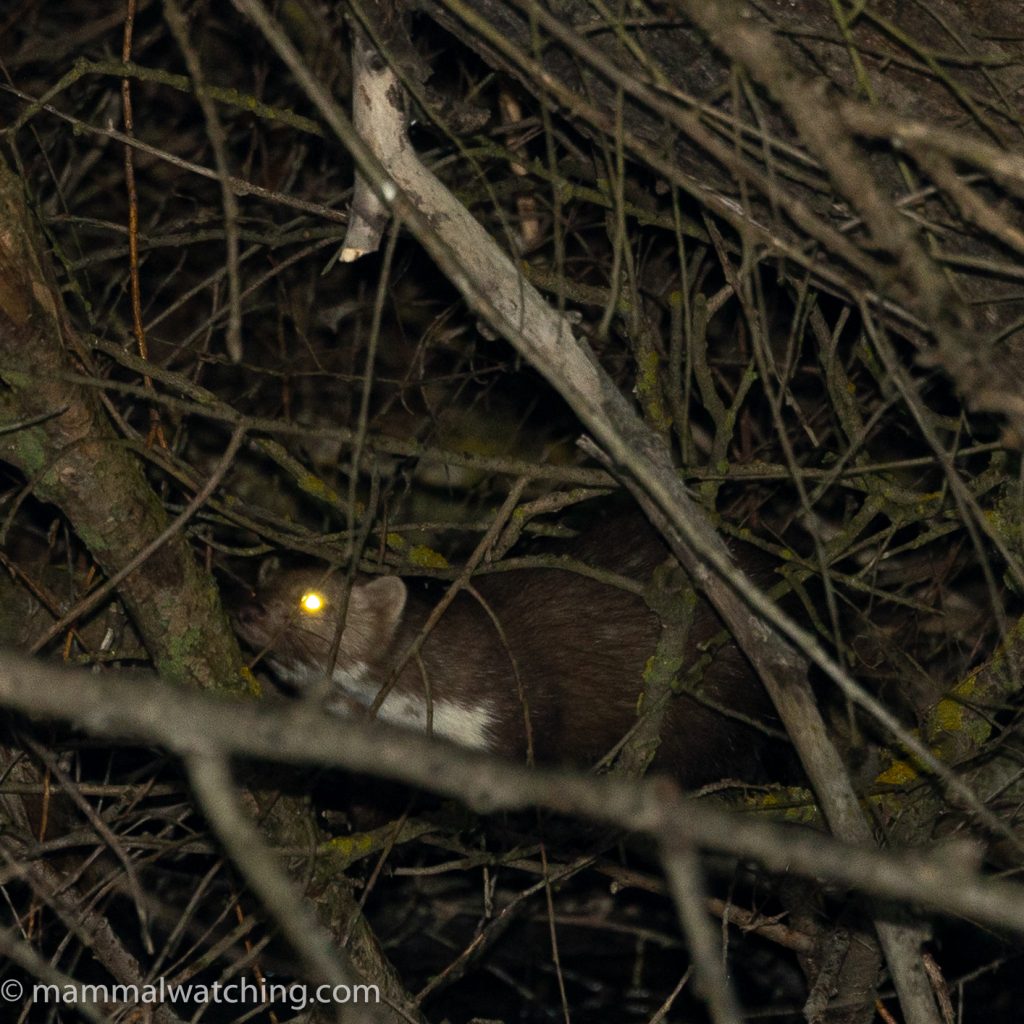
Stone Marten (Martes foina)
One during our night cruise on the Danube Delta.
European Badger (Meles meles)
We saw badgers during night drives around Constanta and Rimetea.
European Mink (Mustela lutreola)
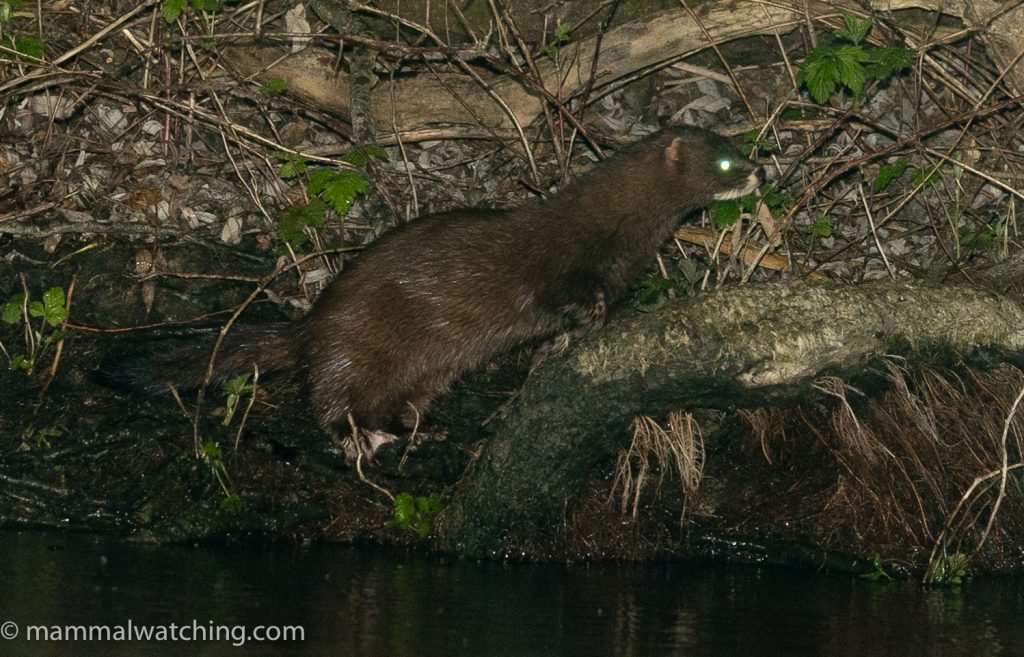
European Mink (Mustela lutreola)
European Mink was a great surprise bonus, and a species I had only seen once before in Spain back in 2011 during a survey.
János arranged our Danube Delta night cruise when he got reports of mink being seen close to Mila 23, a village in the delta. We spent 40 minutes following an animal as it patrolled the river bank and saw a second mink briefly too. One of Europe’s most threatened animals. It also become one of Europe’s most rain sodden night cruises but that is a different story!
Brown Bear (Ursus arctos)
Although the search for the Mehely’s Mole-rat led us to abandon an afternoon in the Hargita Bear Hide, we saw a mother and cub during a night drive close to Hargita.
Golden Jackal (Canis aureus)
We saw several and heard more around Constanta and Iasi.
Red Fox (Vulpes vulpes)
Animals seen on every night drive.
Western Roe Deer (Capreolus capreolus)
Seen at every location.
Western Red Deer (Cervus elaphus)
Several large herds around Hargita after dark.
19 species and 4 lifers
Stuff We Missed
We saw all four of our target mole-rats so really we missed nothing. We had small chances for all three of Europe’s polecats but were not targetting them, though we looked briefly for Steppe and Marbled Polecat around Souslik colonies near Constanta. I may have seen a European Polecat through my thermal scope near Hargita after dark but could not see anything other than eyeshine through my binoculars. But the size and behaviour looked right and they are in that area. If you want to see more of Romania’s mammals you need to take the special Sakertours Mammal bonanza each summer.
Thank you
A very big thank you to János Oláh for inviting me along and organising – perfectly – such an enjoyable and ultimately successful trip, despite the complications caused by the weather. And also to Zsolt Hegyeli, Mole-rat Finder General, for working so hard and with such good humour. And a special thanks to my fellow – very patient – mole-rat watchers. This was a trip with a lot of laughter even in the face of adversity. Finally a shout out to Carlos Bocos for his infectious humour and (sadly not so infectious) boundless energy. He walked 23 km one day patrolling mole-rat burrows to check for fresh activity! The Japanese may have a word for death from overworking but I reckon the Spanish need one for death from overwalking!
Post author
2 Comments
Leave a Reply
You must be logged in to post a comment.


JanEbr
Ehm. I didn’t know how you guessed I was considering Djibouti, but dismissed it as a one-off coincidence … but this starts to look like a pattern. Do you have spy equipment in mole borrows around my place? I was thinking that we could do this mole-rat harvest at some point later and still be original, because, surely, nobody else is crazy enough to actually do it, not to mention someone who doesn’t even live nearby?!